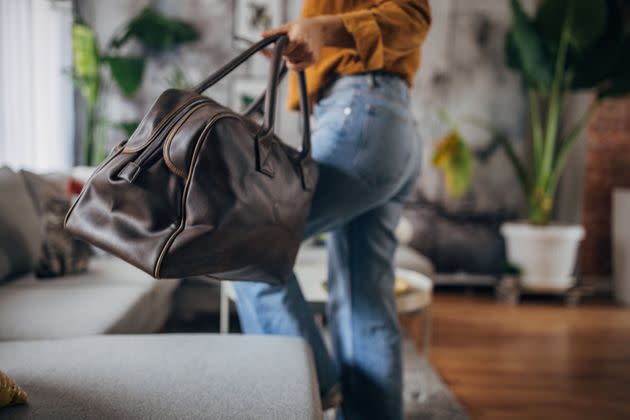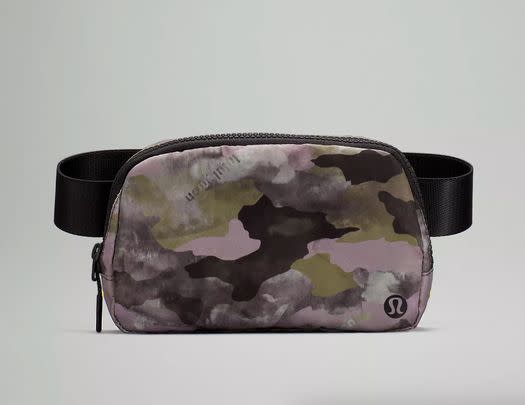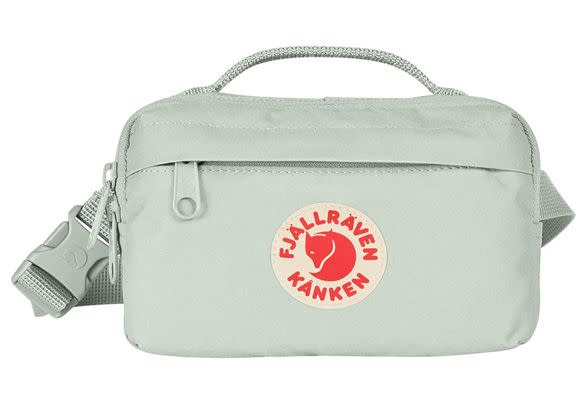As someone who likes to be prepared for anything, I typically travel with a full purse. I fill my tote bag with a spare sweater in case I get cold, a large water bottle so I’m never thirsty, sunscreen for reapplying, a makeup bag for touch-ups, plus all the usual suspects including my wallet, sunglasses, keys and more. When I worked in an office, I also toted a laptop daily (in addition to everything listed above).
My recent conversations with spinal doctors have me rethinking this strategy, however. “Overloading a bag with heavy items can be damaging to wrists, elbows, shoulders or back, depending on where it’s carried,” explained Dr. Kevin Lees, the director of chiropractic operations at The Joint Chiropractic in Scottsdale, Arizona. “Carrying less weight is always the priority. While you can change your bag to help distribute weight more evenly and comfortably, added weight will ultimately affect posture and gait.”
Apparently, the fact that I tend to stuff all those items into a one-shoulder tote bag makes matters even worse. In an effort to shoulder better bag-carrying habits, I spoke with three spine doctors who set the record straight on the best and worst habits for your body.
Improper bag use can have serious health consequences.
If you suffer from back pain, neck pain or stiff traps, your bag might be to blame. “When people wear an inappropriate bag, especially one that places undue strain on the spine, they will frequently develop shoulder pain along with lower neck and upper back pain,” saidDr.Luke Macyszyn, a board-certified and fellowship-trained neurosurgeon specializing in the surgical treatment of complex spinal disorders at DISC Sports & Spine Center.
“These structures are all connected through the large trapezius muscle that runs from the base of the skull to the shoulders, and then to the mid-back. Sometimes, this can arise at the end of the day, but frequently these symptoms begin to develop after days, or even weeks, of using an improperly fitting bag.”
You can cause long-term damage, too. “Many musculoskeletal conditions can arise from improperly carrying bags,” Lees said. “Upper or lower back pain can arise if the gait is changed, or if the person is altering their posture due to an imbalance of weight. Nerve damage can occur if straps are narrow and dig into a person’s skin. Someone consistently miscarrying items may develop back and shoulder fatigue, headaches, back pain and stiffness. Nerve damage can result in tingling or numbness and may lead to weakness or loss of grip strength.”
Even if your bag isn’t causing you pain now, you could be laying the foundation for problems down the road. “Often, physical injuries take a while to become symptomatic, and once they become evident, they can take even longer to heal,” Lees added. “Be aware of your posture and use bags or backpacks safely to avoid long-term damage.”
Spine doctors always avoid heavy one-shoulder bags.
When it comes to bags that are terrible for your back, spine doctors agree that tote bags and shoulder bags are the worst culprits.
“I never use a large tote or shoulder bag,” Macyszyn said. “Not only does this lead to strain on that given shoulder, but it leads to an imbalanced load that is placed directly on the neck as well as [the] thoracic spine. Except for short, necessary periods of use, it’s best that these bags be avoided, especially if prolonged use of a bag is required.”
Dr. Jordanna Clarfield-Henry, a doctor of chiropractic withHealth Haven Clinic in Toronto, echoed those sentiments. “The worst characteristics for a bag, leading to potential damage to your back, often involve poor ergonomic design and improper weight distribution,” she explained. “Carrying a bag over one shoulder rather than evenly distributing the weight across both shoulders can cause spinal misalignment and strain.”
If there’s a lot of weight in your one-shoulder bag, that’s even worse. “Heavy bags exacerbate the strain on your back, especially if the weight is unevenly distributed or concentrated in one area,” she added. “The ideal bag should be lightweight to lessen the overall burden on your back. … If you must have a single strapped bag, then look for one that has a long strap [that] you can wear across your chest and back, making the weight better distributed over a larger area of your body.”
Backpacks are better than totes and shoulder bags, but only if you use them properly.
Although a backpack worn on both shoulders is generally better for your back, you still shouldn’t overload it. “With the ideal bag that fits well, the weight should not exceed 10% of a person’s body weight,” said Lees.
When choosing a backpack, look for an ergonomic design. “Adjustable and padded shoulder straps are essential to evenly distribute the weight of the bag across your shoulders and upper back, reducing strain,” Clarfield-Henry said. “Additionally, a padded back panel provides cushioning and support, preventing discomfort from pressure points. A waist strap or chest strap can further stabilize the bag and alleviate strain on the shoulders.”
Then, you need to position it correctly. “In general, if the backpack is properly fitted (which includes shoulder straps on both sides of the body with proper padding), these bags place a relatively modest strain on the upper back,” said Macyszyn. “It is especially important to ensure that when wearing a backpack, the backpack remains level with the shoulders or a few inches below. In other words, it should not dangle below the waist, as that places increased strain on the upper back musculature.”
The best bag is something lightweight that evenly distributes its load.
Fanny packs and belt bags are popular these days, which is good news for your aching back. “These are usually small and very well supported, [therefore, they’re] not likely to cause any back pain,” Clarfield-Henry said.
Crossbody purses are OK too, “if you have a thick strap and the purse is not too big and full,” as this “distributes the weight over a larger area of the body,” Clarfield-Henry added. In addition, Lees recommends alternating shoulders with each use.
Similarly, “clutches or lightweight purses also pose minimal increased strain for the spine and can be used routinely without worrying about damage to the spine,” Macyszyn added.
If you carry a wallet in your pants pocket, put it in the front pocket or make sure to remove it when you sit. “Not only does [sitting with a wallet in your back pocket] place pressure on the sciatic nerve, but it also leads to poor posture when sitting,” he explained.
Of course, sometimes you’ll need to carry more belongings than a fanny pack or a small crossbody can hold. In those cases, consider a backpack on wheels or small rolling luggage, said Macyszyn, as they place “no load on the spine.”
Need a small crossbody bag? Try a couple of our favorites below.
HuffPost and its publishing partnersmay receive a commission from some purchases made via links on this page. Every item is independently curated by the HuffPost Shopping team. Prices and availability are subject to change.
Lululemon
Everywhere belt bag
In all her glory, here's the OG Everywhere belt bag. Because it's so popular, it's currently only available in this purple camo, but it is often restocked in a ton of different colors.
Amazon
Fjallraven Kanken hip pack with waist belt
You've likely seen this brand's trendy square backpacks on art students and people with mullets and lots of silver chains. It's no surprise they also make a great hip pack in nine colors, like this mint green, measuring just about the size of the Everywhere bag (7.1 by4.7 inches, to be exact). There isn't a strap length listed, but a reviewer says it's about 40 inches long when fully extended. And yes, it has an inner secret pocket.



